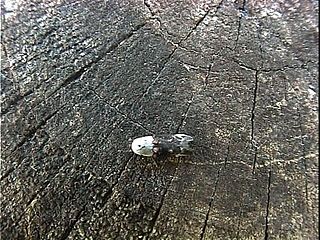
Trachypepla euryleucota is a species of moth in the family Oecophoridae. It is endemic to New Zealand and can be found throughout the country. They inhabit native forest and the larvae are leaf litter feeders and have also been found feeding on and in bird nests. Adults are on the wing from December to March, are nocturnal and are attracted to light. During the daylight hours they can be sometimes be observed resting on walls or fences. It has been hypothesised that the adults resemble an opening manuka flower bud or bird droppings in order to camouflage themselves from predators. The raised tufts on their forewings possibly also assist with camouflaging this moth when they rest on lichen.

Pyrgotis plinthoglypta is a species of moth of the family Tortricidae. It is endemic to New Zealand and is found throughout the whole country. The preferred habitat of this species is native forest. The larvae of this species feeds on rimu leaves from under a silken web. It pupates in loose cocoons amongst rimu foliage. Adults are on the wing from October to May and are night flying. They are attracted to light and can be collected by beating their host tree. The adult insect resembles a small dried fragment of rimu foliage when at rest.
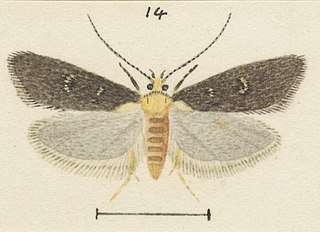
Trachypepla cyphonias is a species of moth in the family Oecophoridae. It is endemic to New Zealand and has been collected in Wellington and Taranaki. Larvae of this species have been reared from kānuka leaf litter. Adults are on the wing in December. This species is classified as "At Risk, Naturally Uncommon" by the Department of Conservation.
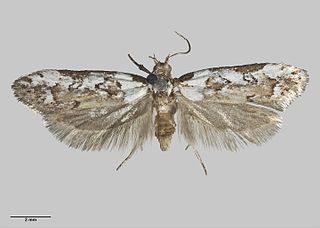
Trachypepla festiva is a moth of the family Oecophoridae and was first described by Alfred Philpott in 1930. It is endemic to New Zealand and has been collected in the northern parts of the North Island.

Tingena anaema is a species of moth in the family Oecophoridae. It is endemic to New Zealand and has been collected at Lake Wakatipu, Invercargill and Stewart Island / Rakiura. The adults of the species are on the wing in December.

Tingena apanthes is a species of moth in the family Oecophoridae. It is endemic to New Zealand and found in the North Island. The adults are on the wing from October to December. It appears associated with Leptospermum species and it has been hypothesised that the appearance of the adults of this species imitates faded Leptospermum leaves.

Tingena aphrontis is a species of moth in the family Oecophoridae. It is endemic to New Zealand and has been collected at altitudes between 3000 - 5000 ft at Arthur's Pass and Mount Arthur. The species lives in open alpine habitat amongst alpine vegetation. Adults of the species are on the wing in January.

Tingena eumenopa is a species of moth in the family Oecophoridae. It is endemic to New Zealand and found in the North and South Islands. The adults have been found amongst tree ferns and are on the wing in December.

Tingena falsiloqua is a species of moth in the family Oecophoridae. It is endemic to New Zealand and has been collected in the North Island. This species frequents subalpine native forest.

Tingena hemimochla is a species of moth in the family Oecophoridae. It is endemic to New Zealand and has been observed in the North Island. Adults of this species are on the wing from December until March.

Tingena letharga is a species of moth in the family Oecophoridae. It is endemic to New Zealand and has been observed in Otago. Adults are on the wing in December and January.

Tingena oxyina is a species of moth in the family Oecophoridae. It is endemic to New Zealand and has been observed in the Otago region. This species inhabits native beech forest at altitudes of between 1000 - 3000 ft. Adults of this species are on the wing in January.
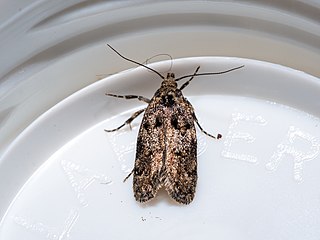
Trachypepla anastrella is a species of moth in the family Oecophoridae. It is endemic to New Zealand and has been observed in the North and South Islands. Larvae are leaf litter feeders from the host plant Olearia fragrantissima and adults are on the wing from December until March.
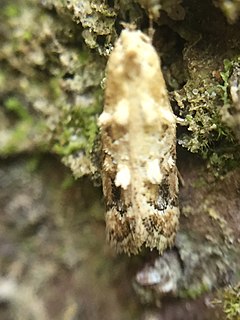
Trachypepla aspidephora is a species of moth in the family Oecophoridae. It is endemic to New Zealand and has been observed in the North and South Islands. Adults are on the wing from November to March and are attracted to light. The moths can be found resting on tree trunks where their colouration imitates lichens.

Trachypepla galaxias is a moth of the family Oecophoridae first described by Edward Meyrick in 1883. It is endemic to New Zealand and can be found throughout the country. This species inhabits native forest. The life history of this species is currently unknown. Adults are on the wing from October to February, are nocturnal and are attracted to light.

Trachypepla importuna is a moth of the family Oecophoridae first described by Edward Meyrick in 1914. It is endemic to New Zealand. Adults have been collected in the North Island in January but the species is regarded as being poorly known.

Trachypepla leucoplanetis is a moth of the family Oecophoridae first described by Edward Meyrick in 1883. It is endemic to New Zealand and has been collected in both the North and South Islands. It is the smallest moth species in the genus Trachypepla and the patterns on the forewings of adults are variable in appearance. It inhabits native forest and bush and the larvae feed on leaf litter. Adults are on the wing from October until February. T. leucoplanetis is regarded as being rarely observed and has been collected via the beating of foliage.

Trachypepla lichenodes is a moth of the family Oecophoridae first described by Edward Meyrick in 1883. It is endemic to New Zealand and has been found in both the North and South Islands. It inhabits native forest and adults of this species are on the wing from November to January. The adult moths are similarly coloured to native lichen species however this colouration is variable in the extent and depth on the forewings.

Trachypepla photinella is a moth of the family Oecophoridae first described by Edward Meyrick in 1883. It is endemic to New Zealand and has been collected in Wellington, Wainuiomata, D'Urville Island and Christchurch. The preferred habitat of this species is native forest and adults are on the wing from December until February.

Trachypepla protochlora is a moth of the family Oecophoridae first described by Edward Meyrick in 1883. It is endemic to New Zealand and is found in both the North and South Islands. The preferred habitat of this species is native forest and adults are on the wing from October until February. Adults can be variable in their green shaded colour as well as in the intensity of markings on their forewings. The greenish ground colouration of this moth ensures they are well camouflaged when at rest on green mosses and lichens.






















